
Explore Puerto Rico
Puerto Rican Dishes
Whether in its capitol city of San Juan, or along its dreamy coast, you’ll find a cuisine full of rich flavors, unique spices, and fresh ingredients.
Whether your style is contemporary, classic, urban, or full of history, Puerto Rico has works of art that will inspire you with the island’s distinct interpretation of Caribbean culture.
Puerto Rico is a cultural hub with nearly every type of art represented. Throughout Puerto Rico there are almost 80 museums that cover art, design, history, anthropology, and science. On top of museums, Puerto Rico is home to amazing music and culinary festivals, galleries, ballets and contemporary dance, theater, and public art, like sculptures and street art.
Furthermore, Puerto Rico's arts and cultural scenes last through the night with live music, dancing, and parties throughout the Island almost every day of the week.
Puerto Rican Deep-Fried Dishes
If you ever find yourself in Puerto Rico, the chances are that you will make a stop at the beach. In beachside places like Piñones or Luquillo, you will find the typical chinchorro or beach kiosk where frituras or deep-fried foods are the main dishes accompanied with coconut water or a cold beer.
When heading into Piñones the first thing that hits you is not the smell of the ocean, but of the frituras. Kiosks filled with fried food line the two-way street that borders the beach. What makes these kiosks genuine is that most of the food is made over a wood fire, bringing out the true flavor of these fried dishes.
Alcapurrias
Made from green plantains and yautía (taro root), this ‘dough’ is often filled with stewed crab meat, ground beef, chicken, and even seafood. Once stuffed, it is fried in a large pan filled with hot oil over an open wood fire until golden brown.
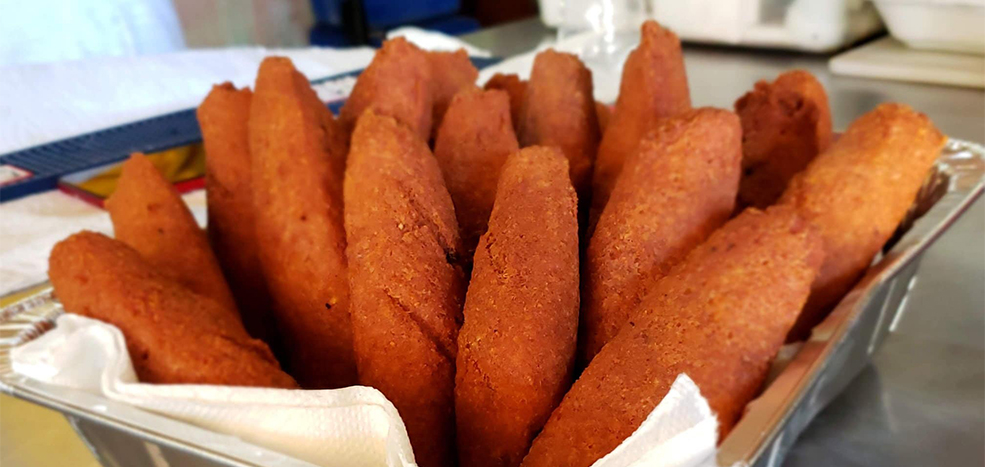
Alcapurrias
Yautía, also known as malanga, is a kind of tuber that can be cooked and eaten like a potato, dried and turned into starch, or pounded into dough. The dough is dyed orange-gold with achiote, known in English as annatto. After stuffing with picadillo, the dough gets formed into a little cigar and then deep-fried. Alcapurrias are a popular street food on Puerto Rico's coasts, where many street stalls offer the deep-fried treats. In addition to the beef-filled variety, you can also find versions stuffed with crab or bacalao.
Bacalaitos
These cod fritters are usually served at beach kiosks, but can also be found at road-side establishments and at cultural festivals. Like the alcapurria, they are fried in hot oil, resulting in a crispy coating and a soft but chewy center.
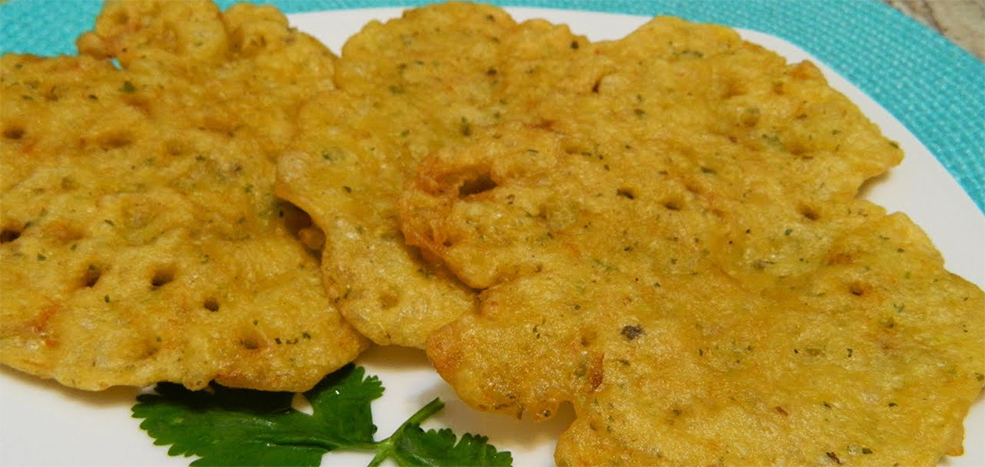
Bacalaitos
Bacalaitos are a type of fritter or pancake made from salted fish (traditionally cod, though pollock works too). The preserved fish is inedibly salty when you buy it, and needs to be pre-prepped before you can use it in recipes.
Rellenos de Papa
Rellenos de papa are another fried food typically sold by vendors as a street snack. These crispy balls are stuffed with mashed potatoes and a basic ground beef filling (or picadillo).

Rellenos de Papa
When you bite into rellenos de papa, the delicately crispy shell quickly gives way to starchy, fluffy mashed potatoes. These would be delicious potato fritters even if they didn't have any stuffing, but the picadillo in the middle elevates them to another level. The savory meat with hints of acidity and sweetness makes these really special.
Empanadillas
Deep-fried pie that's filled with meat that you can eat on the go! Empanadillas (also known as empanadas or pastellitos) are a type of savory or sweet hand pie that's popular all over Latin America. Think of them as the original Hot Pocket, only a million times better. They're a popular treat in bakeries on the island.
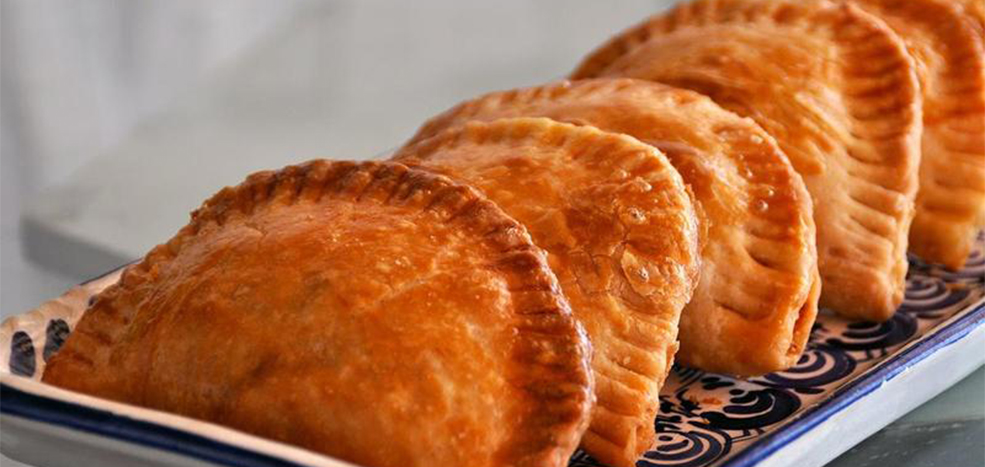
Empanadillas
These terrific turnovers are filled with a savory mix of ground beef and potato. Puerto Rico’s most popular fillings are lobster, conch, and shrimp.
Sorullitos de Maiz
Sorullitos de maiz, also known as sorullos or surullitos, are finger-shaped corn fritters usually filled with cheese. You can think of them as the Puerto Rican version of mozzarella sticks. They can be eaten as a snack, a breakfast food, or a side with a larger meal. Sometimes sorullitos are sweetened, but it's also common for them to have a more savory flavor profile.
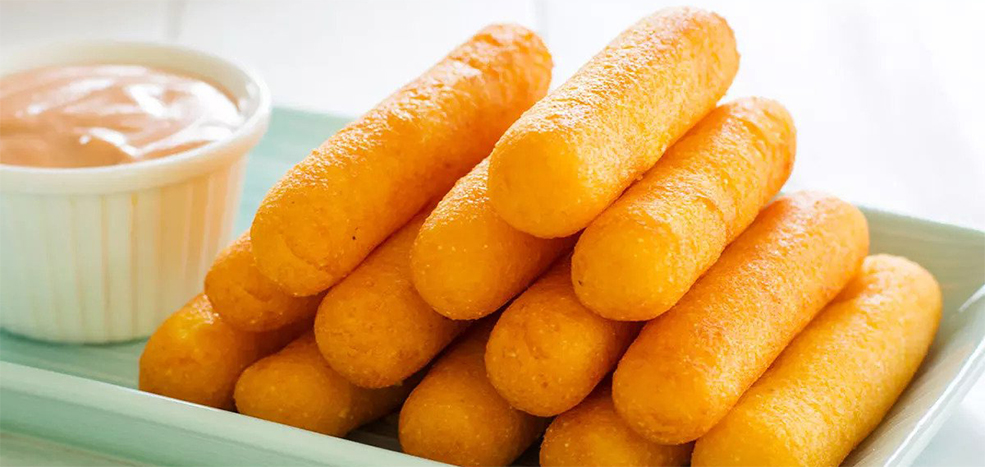
Sorullitos de Maiz
This dish gives you a wonderful contrast between a crispy exterior and gooey, cheesy filling. The specific type of cheese varies depending on the recipe.
Pinchos
The word pincho originates in Spain's Basque region. In that area, the term refers to any kind of snack or appetizer served on a skewer. The word can even be used more broadly to refer to any kind of Basque tapas-style snack.
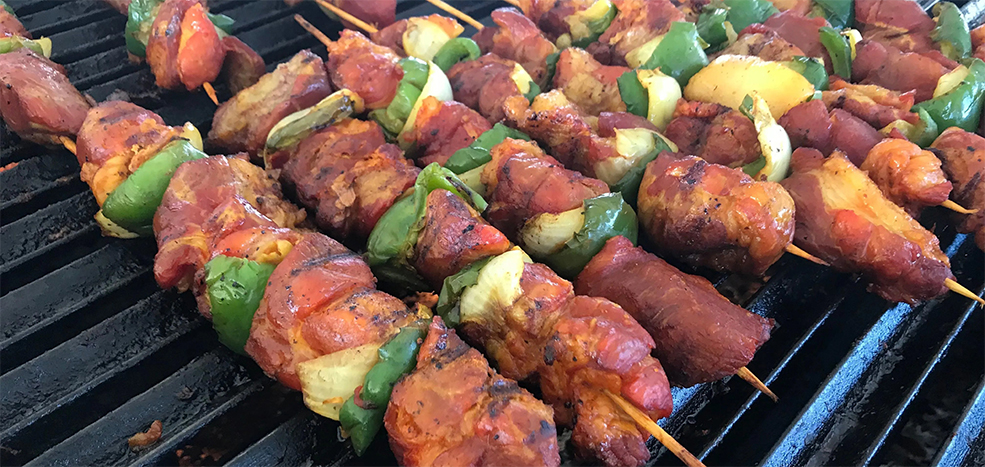
Pinchos
In Puerto Rico, however, a pincho is specifically a skewer of grilled, marinated meat, usually served with a piece of bread and some barbecue sauce. They're a common street snack, and people also make them for family cookouts. The Noshery's recipe uses chunks of chicken thigh marinated in a mixture of olive oil, sazón, oregano, and white vinegar.
Chicken isn't the only meat used in pinchos. Pork is another popular choice, and a recipe in Delish calls for tenderloin soaked in a garlicky marinade. Whatever meat you choose, pinchos are a fun variation on BBQ that are easy to make at home for a crowd.
Chicharrones de Pollo
In Spanish, the word "chicharrones" refers to crunchy pork rinds. Puerto Rican chicharrones de pollo is a special type of fried chicken that is so crispy that it almost mimics the texture of chicharrones.
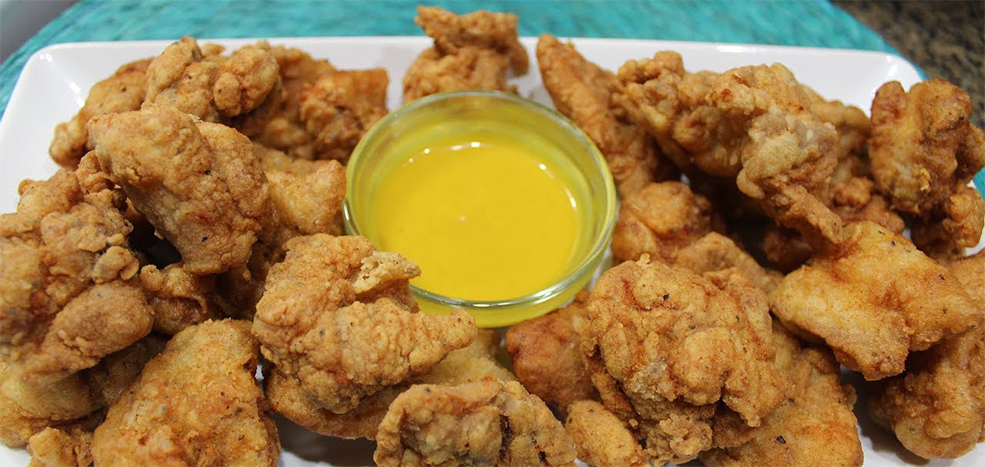
Chicharrones de Pollo
Puerto Rican Plantain Dishes
Plantain is a key ingredient in various Puerto Rican meals. This versatile element is the star of many dishes ranging from savory to sweet.
Tostones
The easiest of all the plantain-based dishes, for which you need only a green plantain and you are good to go. This side dish is made by peeling and cutting the plantain into small slices. You can leave them in a saltwater bath for a few minutes before frying for added flavor.
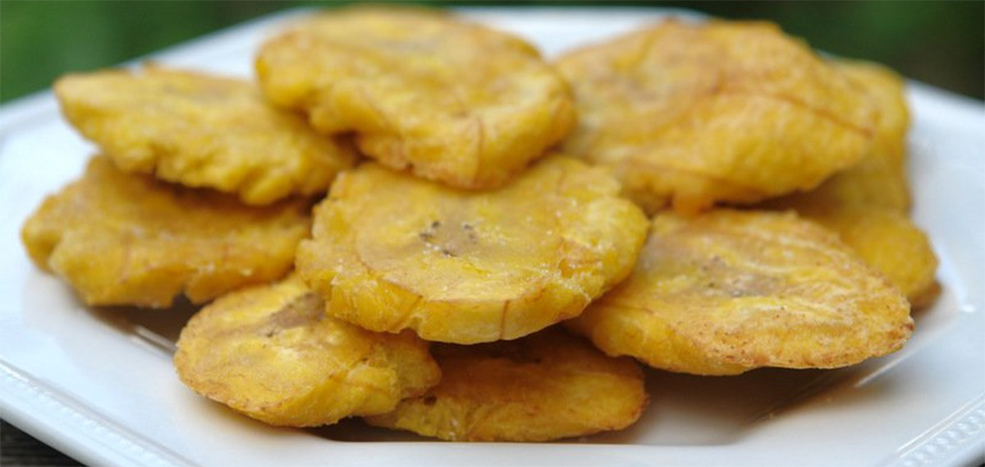
Tostones
Once fried in hot oil, they are squashed with a tostonera and fried once more until crispy and golden. Tostones are best eaten with a mayo-ketchup dipping sauce. They can be eaten alone or topped with chicken, meat, or seafood.
Amarillos
If you are not a fan of salty and savory, then the sweet version of the tostón may be your flavor.
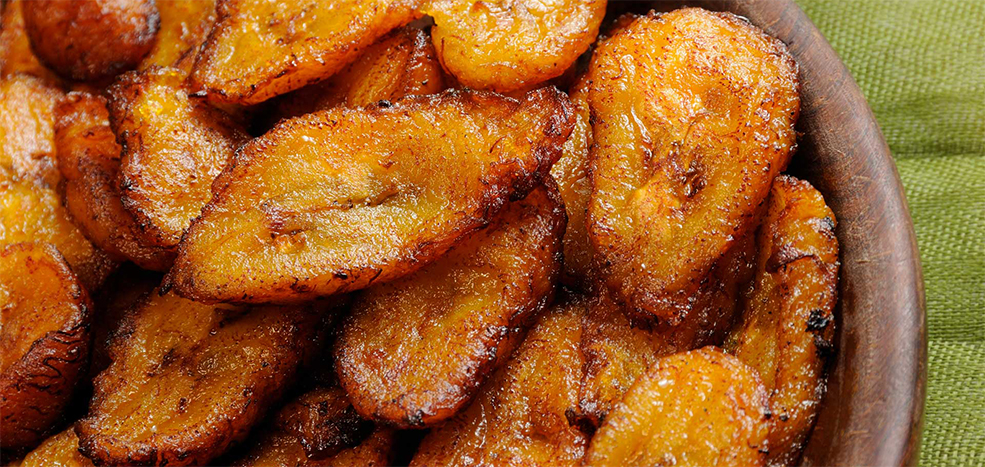
Amarillos
The difference is that it is made from a ripe plantain (one that has yellowed) that is peeled, sliced, and fried only once. Even though it is a sweet alternative, amarillos are often a side dish to the main course.
Arañitas
Arañitas means "little spiders" in Spanish, but don't worry: No arachnids are harmed in the making of this savory fried treat. Arañitas are actually fritters made with grated and fried plantain. They're called little spiders because the crispy threads of plantain look sort of like spider legs. This snack is made with plantains that are still unripe and green. This is when they're at their starchiest and least sweet. The process is very similar to the way you'd make hash browns with potatoes.
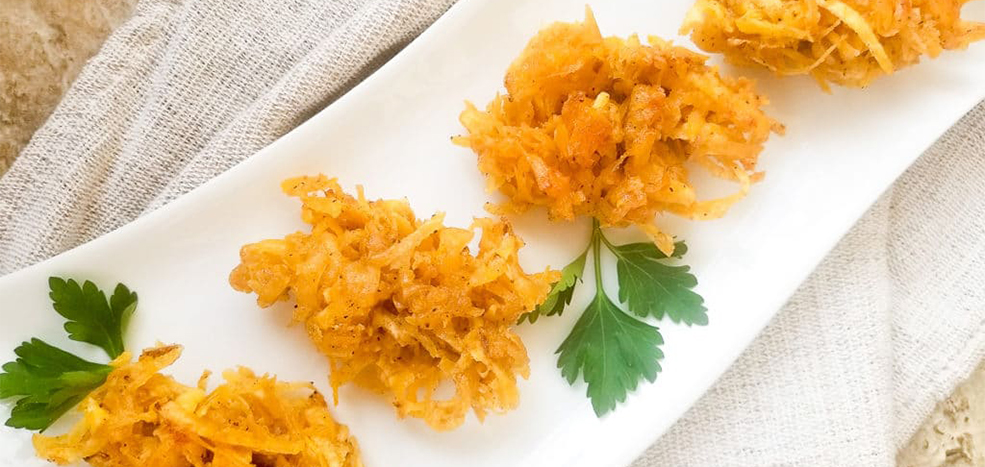
Arañitas
Arañitas are often served as a side dish, but they can also be a standalone snack when served with a dipping sauce. You can go with a blend of mayonnaise and ketchup and get fancy with some cilantro aioli or cocktail sauce.
Pionono
Pionono (Stuffed Fried Plantain) — savory plantain rolls stuffed with a tasty beef filling – Picadillo. An out-of-this-world Puerto Rican snack that’ll reminds you of sunshine and the blue sea. Truly a delectably sweet plantain and savory beef combo rolled into one!
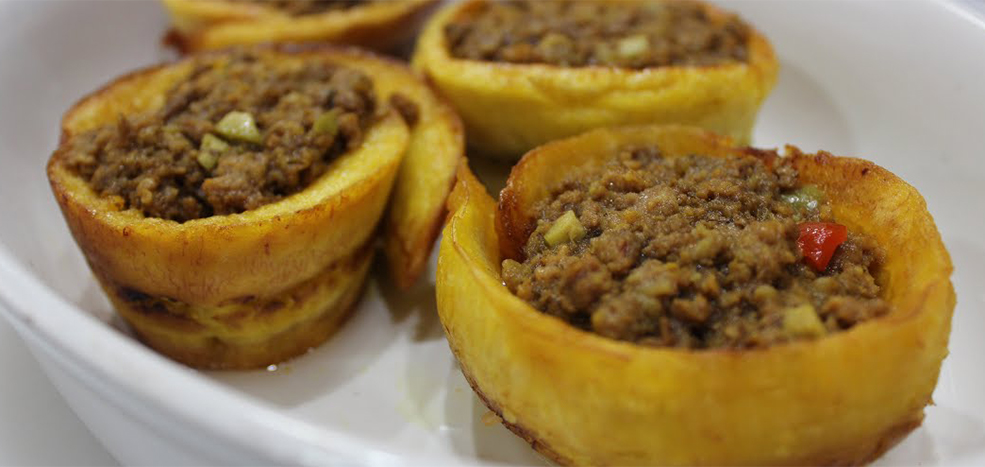
Pionono
This is made from a ripe plantain. Once sliced and fried, it is rolled into a sort of recipient for the meat filling. With an egg wash and grated cheese sprinkled over, it is put in the oven. The outcome is a sort of Puerto Rican meat pie. When you want the flavors of sweet plantain, savory beef picadillo and cheese, trying making Puerto Rican Piononos. These bite sizes treats are a cute cousin to the Pastelon, that are shaped like cupcakes. They are fried and then bake until perfectly firm.
Pastelón
Classified as the ‘Puerto Rican plantain lasagna’, this is a mixture of sweet and savory. The dish combines fried ripe plantain with layers of ground beef for a unique flavor.
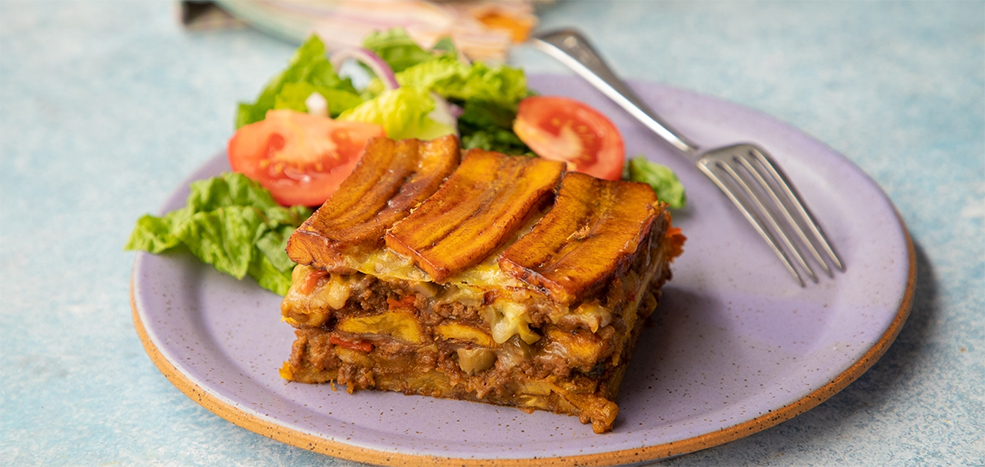
Pastelón
Pastelón is a plantain and beef casserole that's kind of like the Puerto Rican equivalent of lasagna. Rather than lasagna's layers of pasta, ragu, and bechamel or ricotta, pastelón stacks thin slices of fried ripe plantains and layers of picadillo, finishing off with a mixture of eggs and baking soda that holds everything together while it bakes.
Mofongo
Mofongo is a Puerto Rican dish made from fried unripe plantains which are then pulverized or mashed. The starchy dish is further enriched by the addition of ingredients such as lobster, prawns, garlic, chicken, or bacon. The king of all the plantain-based dishes, this is a centerpiece of Puerto Rican food. It is made out of fried green plantains that are mashed and seasoned with garlic and olive oil.

Mofongo
Mofongo is usually topped off with chicken, meat, and even shrimp! A true volcano of flavors, and can be found anywhere across the island and is often accompanied by a side of white rice.
Guanimes con Bacalao
A dish with a Taíno ancestry, these are part of a typical Puerto Rican meal.
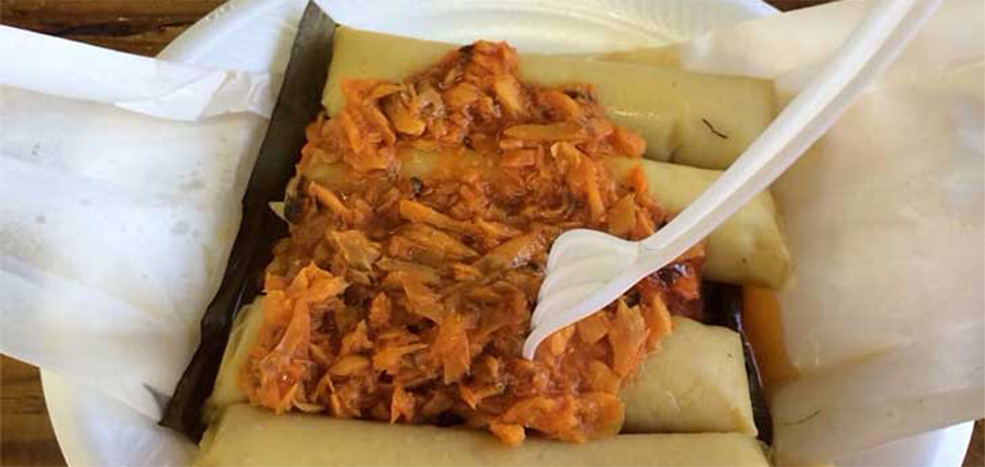
Guanimes con Bacalao
The guanime is made from cornflour and coconut milk. This is mixed together until it forms a masa dough and is molded over a plantain leaf and tied off before boiling. It is served alongside stewed cod.
Puerto Rican Rice Dishes
Rice is another staple ingredient in Puerto Rican households and can be rearranged to be included in many main dishes and even desserts.
Arroz Mamposteao’
This white rice and red kidney bean variety includes the key element of sofrito. Anyone who grew up in a Puerto Rican home, knows that there is always a butter tub filled with a green paste.
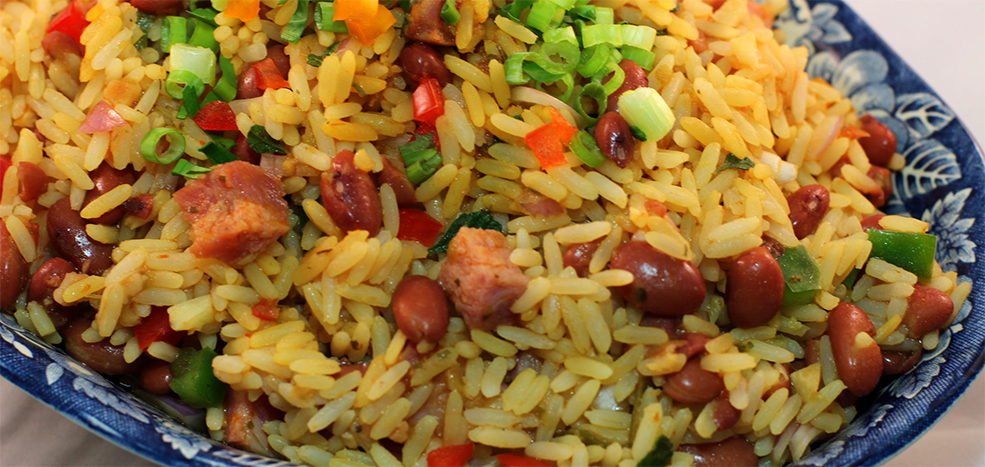
Arroz Mamposteao
This sofrito is mainly made out of a mixture of peppers, onions, garlic, peppers, culantro, and cilantro. This mixture is what gives this rice dish that extra savory kick along with the sauteed diced ham.
Arroz Blanco con Habichuelas y Carne Frita
This is one of the best-known dishes from Puerto Rico, as it is simple, not too exotic, and is perfect for any meal. It is essentially just white rice, served with beans and meat, all mixed together with some sauce. The meat can vary according to preference, but it is most commonly either fried pork chops or beef.
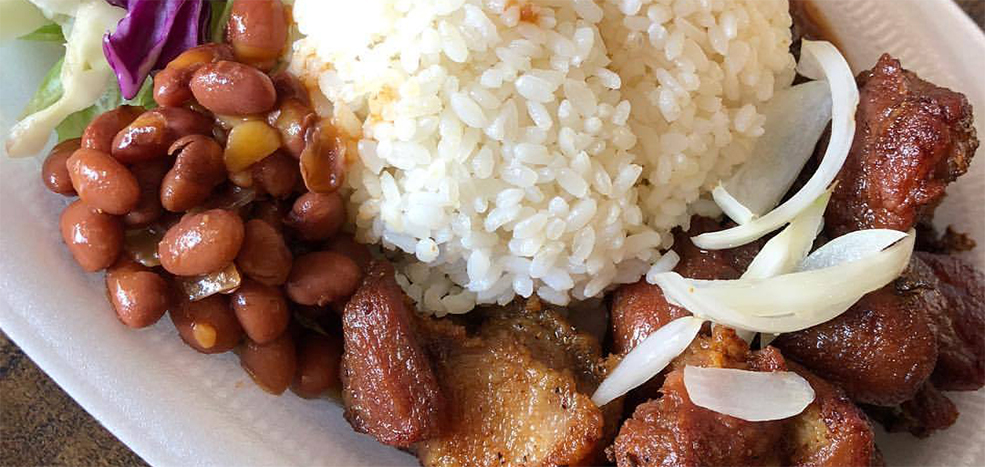
Arroz Blanco con Habichuelas y Carne Frita
Rice and beans are a staple meal in any Puerto Rican household and is often served with meat, for example fried pork chops.
Arroz con Gandules
Arroz con gandules is a one-pot national dish of Puerto Rico consisting of rice, pigeon peas, and sofrito, and every family in the country has their own version of the recipe. Sofrito is the aromatic flavoring base for a variety of Puerto Rican dishes, made with green peppers, onions, garlic, and coriander.
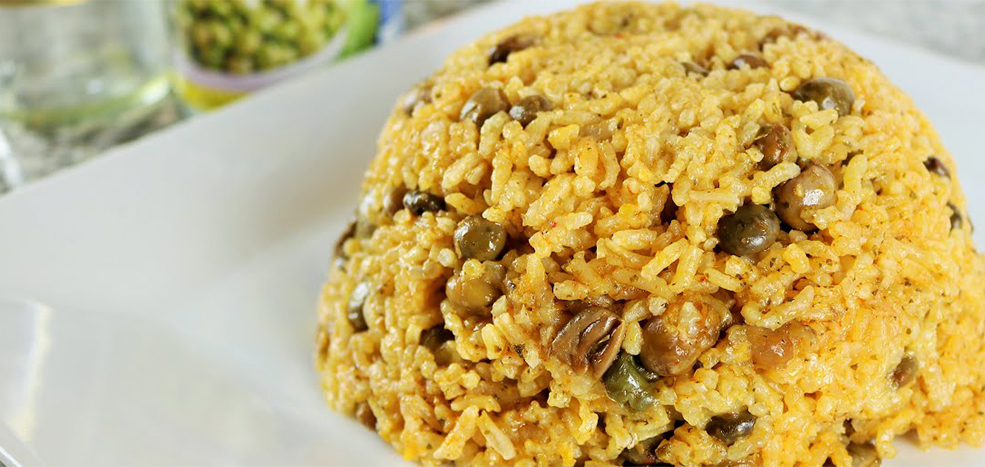
Arroz con Gandules
Some people may fry bacon in sofrito to add a smoky flavor to the finished dish. Other spices and garnishes in arroz con gandules might include cumin, bay leaves, oregano, tomato paste, olives, lime juice, and (not traditionally) sour cream. Although flavorful in its original, vegetarian version, it can also be made with added pork meat or sausages. This dish with sofrito is a staple dish served during family gatherings, Thanksgiving, and Christmas time.
Arroz con Dulce
If you still haven’t had your fix after indulging in all of the savory rice dishes Puerto Rico has to offer, then you need to get your hands on some arroz con dulce. It is a sweet coconut rice pudding that consists of rice, coconut milk, cinnamon, sugar, cloves, and nutmeg. It’s also typically garnished with raisins and cinnamon sticks.
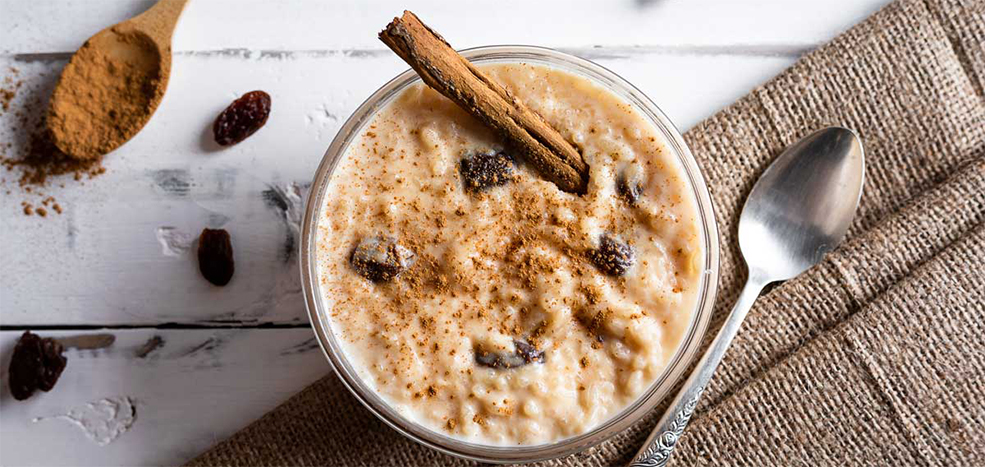
Arroz Con Dulce
Arroz con dulce means sweet rice and it is a Puerto Rican rice pudding that has a coconut base. It is a typical dessert during the holidays.
Puerto Rican Soups
A good soup is comfort food on a rainy day or when you’re feeling under the weather. Many Puerto Ricans will recall their grandmother serving them soup when they were sick. And as luck would have it, these are often sopa revive muertos, which is to say, soups that can raise the dead.
Asopao de Camarones
Asopao de Camarones (Shrimp and Rice Pottage) is a fantastic dish that is easy to make, with a very forgiving recipe, and sometimes prepared for informal get-togethers.
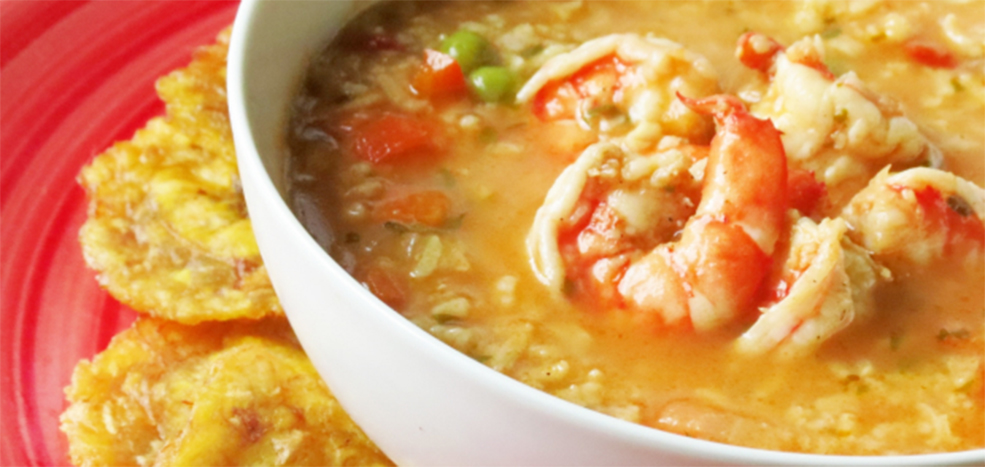
Asopao de Camarones
This soup is characterized by its main ingredient: shrimp. It is made in a stew with sofrito, onion, peppers, garlic, tomato sauce, and rice. A hearty meal that is often accompanied by a slice of avocado.
Sopón de Gandules
This simple vegetarian stew makes a hearty and inexpensive main course. It showcases fresh pigeon peas (gandules verdes), which are a staple in Puerto Rico. The small, round legume is similar in size to an English pea. Serve this with rice, tostones (fried plantains) or viandas (steamed or boiled root vegetables).
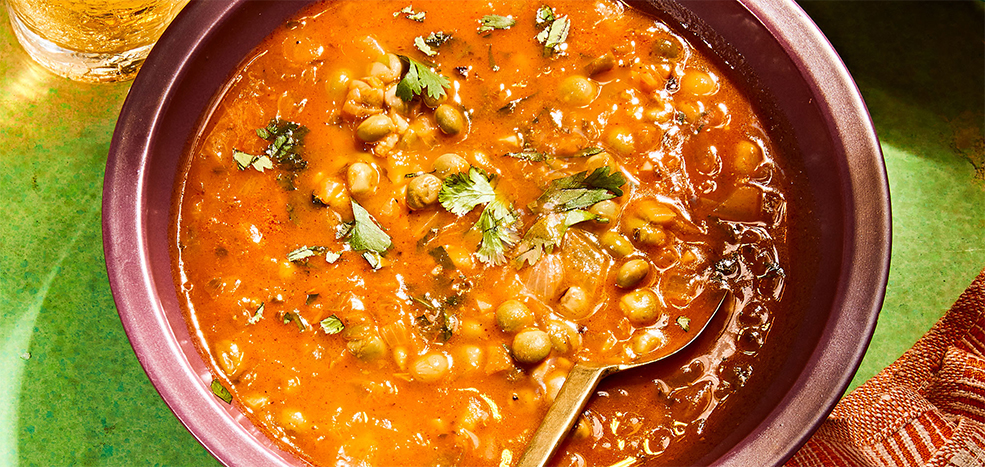
Sopon de Gandules
A bowl of hot pigeon pea soup will lift any spirit and have you sweating in no time. Like the shrimp soup, it can have a side of avocado or small balls of plantain can also be added to the stew.
Asopao de Pollo
Asopao is Puerto Rico’s national soup and one of the most important gastronomic recipes in Puerto Rico. Perfect for cold winter nights, asopao is a somewhere between soup and a stew. Tender bits of chicken are simmered in a flavorful stock, then rice is added and cooked until tender.
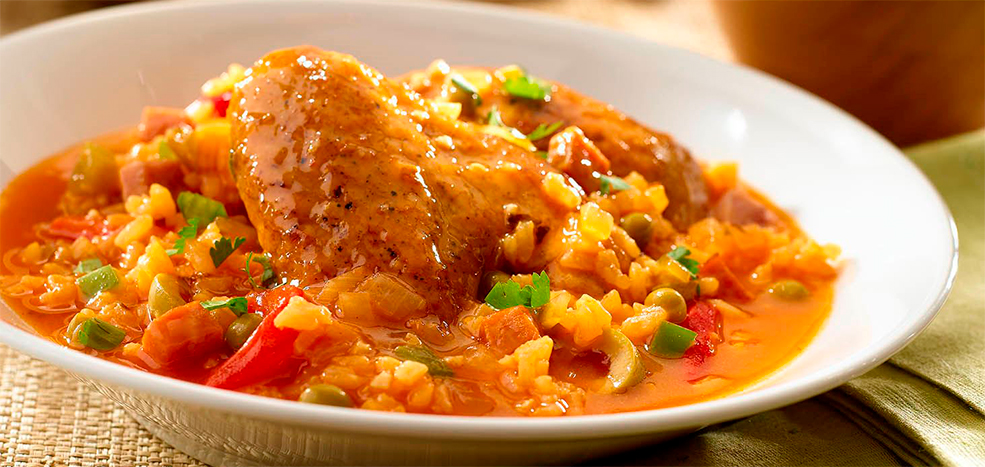
Asopao de Pollo
Unlike arroz con pollo, asopao is more similar to a risotto, where the rice becomes really plump and creamy, due to the extra liquid added to the pot during cooking. It’s meant to be eaten with a spoon, and also happens to be a classic recipe to serve to late-night guests during the holiday season (along with coquito)! Asopao de pollo is the perfect dish to make when you need something warm and delish to fend off winter’s grip.
Asopao plays a starring role in a Puerto Rican form of partying called a parranda. It's somewhat similar to the English traditions of caroling or wassailing, in that groups of singers go from door to door begging for refreshments. Unlike the tamer wassailing, however, parrandas happen late at night, and the group of singers, or parranderos, ritualistically "kidnaps" each household they visit, bringing them along to harass the next house. Traditionally, asapao de pollo was the food of choice for parrandas because you could prepare it ahead of time and reheat it when you were rudely thrust out of bed.
Puerto Rican Pastries
Many of these pastries can be found in the local panadería, which is akin to a coffee shop and bakery, where you can grab a ham and cheese sandwich and a cup of café con leche.
Flan de Queso
Flan is popular in many different countries. You can find multiple flavors of flan sold in Puerto Rican panaderias, including a fruity kind made with guava as well as this ultra creamy version.
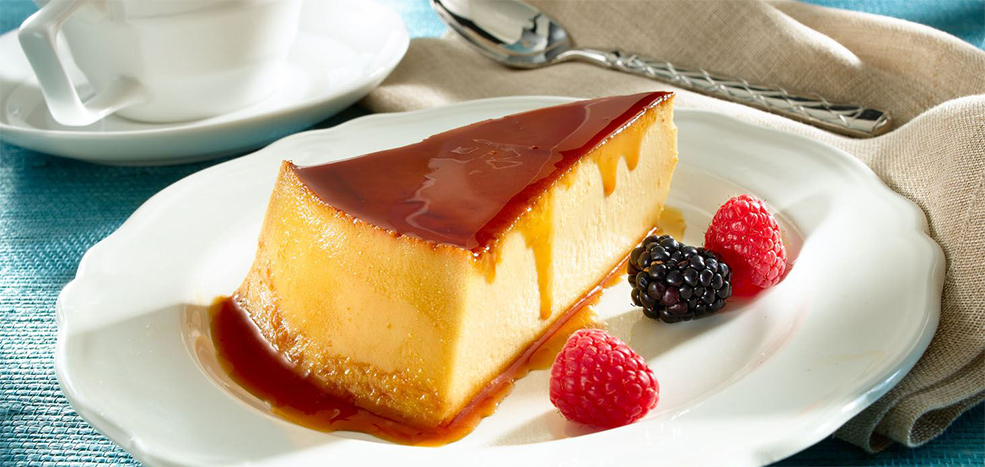
Flan de Queso
The addition of cream cheese to flan de queso changes the texture of the custard, making it reminiscent of cheesecake filling. The hint of tang from the cheese also gives flan de queso a little more depth of flavor than a plain vanilla flan.
Other than the cream cheese, flan de queso is pretty much the same as any other flan. You cook a caramel, then pour an eggy custard batter over the top. The whole thing gets baked together, then (carefully) inverted so the liquid caramel oozes over the top.
Brazo Gitano
Brazo gitano is a dessert inherited from Europe and adapted to local Puerto Rican cuisine. Also known as swiss cake, Brazo Gitano is a roll cake filled with guava and powdered with sugar. Carrot flavor with cream filling is also a popular rendition.
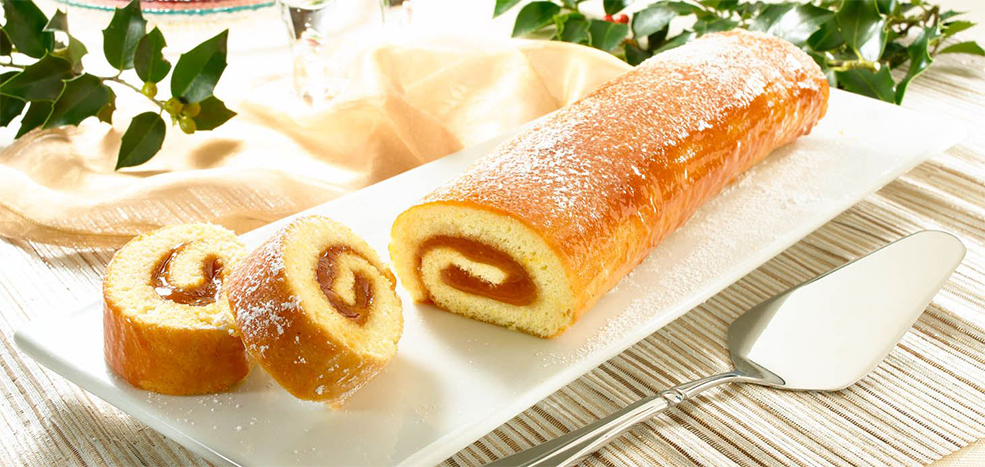
Brazo Gitano
Brazo gitano means ‘gypsy arm’ and is a sort of rolled sponge cake that has a guava jelly filling and is sprinkled with confectioner’s sugar. Even though it is not a purely Puerto Rican creation, its roots in Puerto Rico can be traced to Mayagüez on the west coast of the island.
Pastelillos de Guayaba
Pastelillos de Guayaba (Guava Pastries) are a delectable treat that are perfect for a scrumptious dessert, breakfast or snack. Made with just 3 simple ingredients! Don’t forget the coffee!
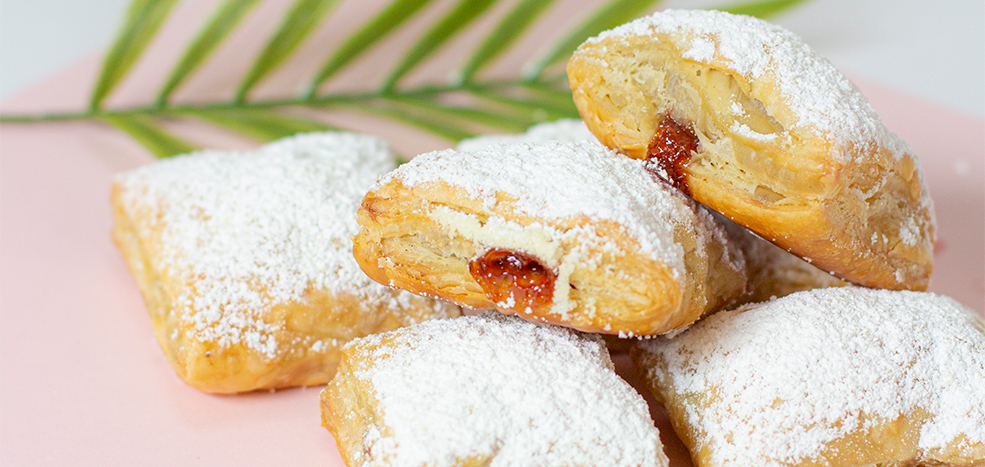
Pastelillos de Guayaba
Also known as guava turnovers, these are a type of filo pastry filled with guava paste and served sprinkled with sugar. In Puerto Rico Pastelillos de Guayaba the equivalent of an apple danish in the States. They’re eaten in the morning or afternoon with a hot cup of café con leche. Guava paste- made thick from slowly boiling guava pulp- is wrapped in flaky, buttery puff pastry and baked until golden. The pastries are then finished with a deluge of powdered sugar.
Quesitos
In English, quesitos means "little cheeses." They are small cigar-shaped baked treats made with puff pastry and filled with sweetened cream cheese. You can find them in panaderias throughout the island of Puerto Rico. After they're baked, they get brushed with a simple sugar syrup that adds sweetness and makes the outside of the pastry extra glossy.
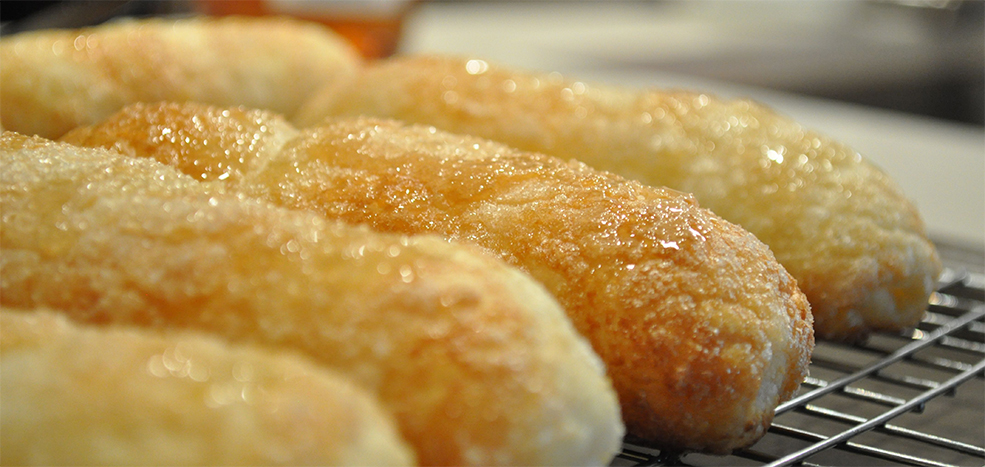
Quesitos
The most basic filling is a simple mixture of sugar and cream cheese, but you can find quesitos in a variety of delectable flavors. Guava paste is quite popular and pairs well with the cream cheese. Dulce de leche, jam, and nuts also occasionally make their way into quesitos.
This puff pastry is a throw back to the European history that is inherent in the island. This light and flaky dessert has a sweet honey outer coating and is filled with cream cheese. It usually served as a coffee break treat and is best when accompanied by café con leche (coffee with milk).
Pan de Mallorca
Pan de Mallorca was invented on the Spanish island of the same name, but it's a classic Puerto Rican sweet bread. Prepared with a soft, fatty, enriched yeast dough, pan de Mallorca is kind of like a cinnamon roll without the cinnamon. It's even made in a swirled shape like a cinnamon roll.
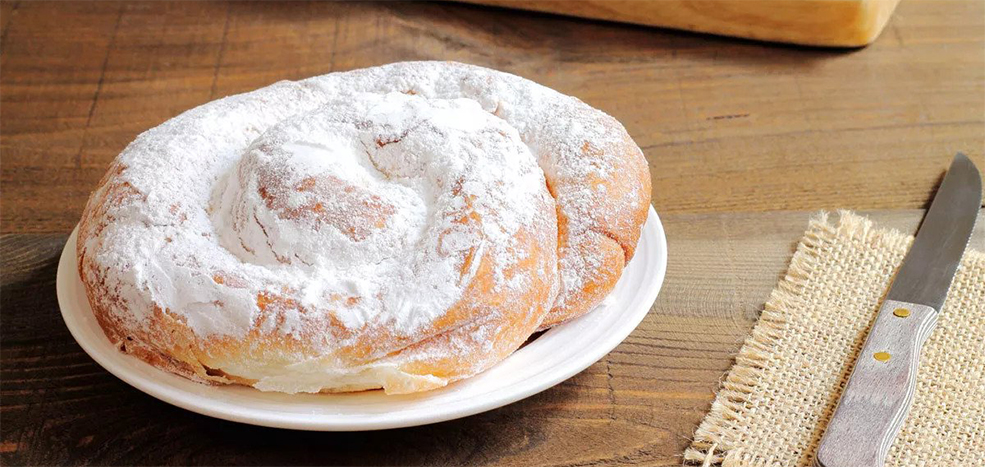
Pan de Mallorca
Pan de Mallorca has a hint of sweetness, both from a small amount of sugar in the dough and a dusting of powdered sugar over the top. It's popular to eat it for breakfast alongside a cup of coffee. You can also use it as a sandwich bread, as its mild sweetness is somewhat similar to a Hawaiian roll or potato bread.
Mallorcas are a sort of Puerto Rican sweet roll with powdered sugar. You can get them at a panadería. As a sandwich, it ranges from the most basic of a plain mallorca with butter to the breakfast staple mallorca with ham, cheese, and scrambled eggs.
Bizcocho de Novia
Bizcocho de novia means "bride's cake," but it reminds us more of funfetti cake than anything you'd find at a wedding. It's an extra-fluffy vanilla cake topped with an airy vanilla frosting and a generous dusting of multicolored sprinkles. This sweet treat is ubiquitous in Puerto Rican bakeries. The cake is extra fluffy because the eggs, oil, and sugar in the batter are creamed for a very long time until they hold a lot of air.

Bizcocho de Novia
One of the things that sets bizcocho de novia apart from a regular white vanilla cake is the textural contrast you get in each bite. In addition to the sprinkles on top, there's also a crunchy sugar layer on the bottom of the cake. This is made by resting the baked cake layers on a bed of granulated sugar while they're being frosted. The frosting is made with a mixture of whipping cream, vegetable shortening, and powdered sugar.
Tres Leche
The cake with three milks is one of the most traditional recipes of Latin America and knows many versions depending on the country, all united by the use of three different types of milk: whole milk (or cream), evaporated milk and sweetened condensed milk.

Tres Leche
Tres leches cake (or pastel de tres leches in Spanish) consists of a base of sponge cake whose unique consistency is due to this particular moisture of the three combined milks, which makes the cake fresh and airy. It has the particularity of never crumbling. This Puerto Rican sponge cake is made with three different types of milk: evaporated milk, sweetened condensed milk, and full-fat milk. The result is an airy and moist cake with a whipped cream topping.
Tembleque
This coconut milk-based pudding means ‘jiggly’ and is a traditional Puerto Rican Christmas dessert that is often sprinkled with cinnamon. It's named after the Spanish word for "shake," "temblar," and it definitely lives up to its name when it pops out of the mold in all its jiggly glory. Unlike Jell-O, which is thickened with animal gelatin, tembleque uses cornstarch, so vegans and vegetarians can eat it. To make it, you combine coconut milk with sugar, seasonings, and cornstarch, and cook in a saucepan until the starch gelatinizes. Then you pour the hot mixture into a pan and chill to set.
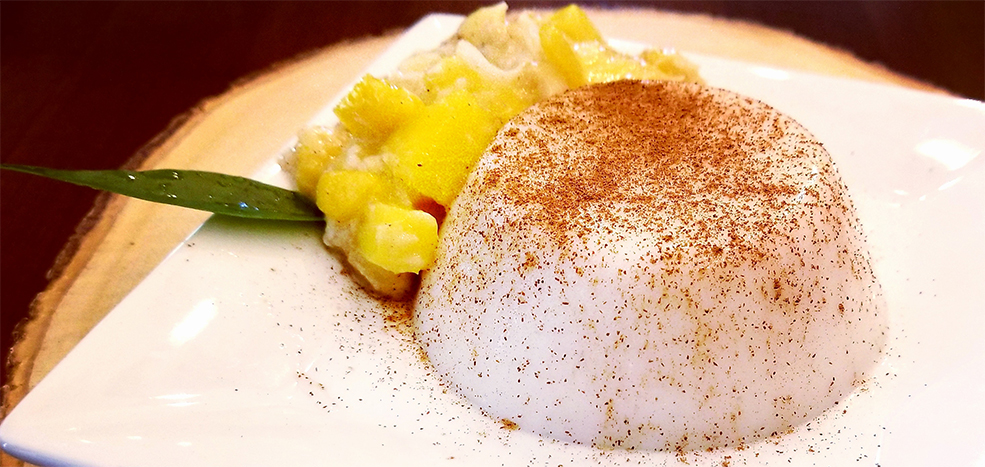
Tembleque
Flavor-wise, tembleque tastes festive and tropical, with the sweet flavor of coconut harmonizing with lime, cinnamon, and vanilla. The great thing about this dish is that it's not too complicated to recreate so if you love it when you try it in Puerto Rico, you can make it at home. All you need is milk, sugar and cornstarch. Just remember that the sweet coconut milk is the star of this light dessert and you'll bake up something truly remarkable.
Bizcocho de Ron
In Puerto Rico, rum cake is known as bizcocho de ron. It is made of a sponge cake that is soaked in the alcohol, and sometimes fresh or dried fruit is added, such as raisins or coconut.
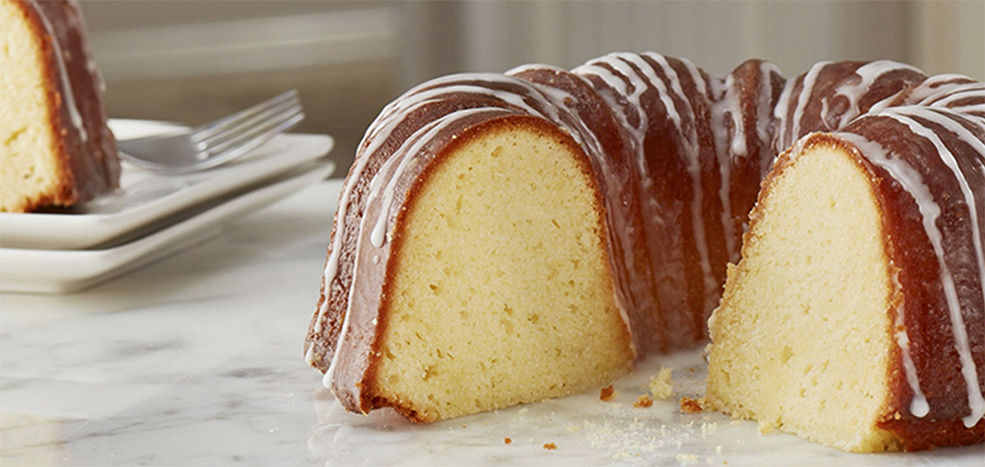
Bizcocho de Ron
Bizcochos de ron popular gifts during the holiday season. (But don’t worry! It wouldn’t get thrown away like an American fruit cake.) Recipes for this cake vary, but the one constant is that they're not shy about using a substantial amount of rum.
Puerto Rican Christmas Dishes
Christmas is one of the most popular and highly celebrated holidays across Puerto Rico. It is packed with many festivities that tend to start after Thanksgiving and last until the eight days after Three Kings Day, better known as las Octavitas. Christmas marks a time not only of celebration but also of togetherness. This is also the time of year where many Diasporicans (Puerto Ricans that live outside the island) return home for the holidays to celebrate with loved ones what is probably the longest Christmas in the world. Tsupehis means that a variety of food has to be provided to fuel all that jolgorio (merriness).
Christmas dishes consist mainly of four ingredients: coconut milk, vanilla extract, sugar, and cinnamon. Believe it or not, there are infinite versions of this combination, the epitome being Coquito.
Coquito
Coquito is more than your regular old eggnog; it has a coconut cream and rum base, and some variants are even made with Nutella and pistachio for added flavor. Best served cold, this Puerto Rican Christmas beverage will have you singing aguinaldos (Puerto Rican Christmas songs) around your living room in no time.
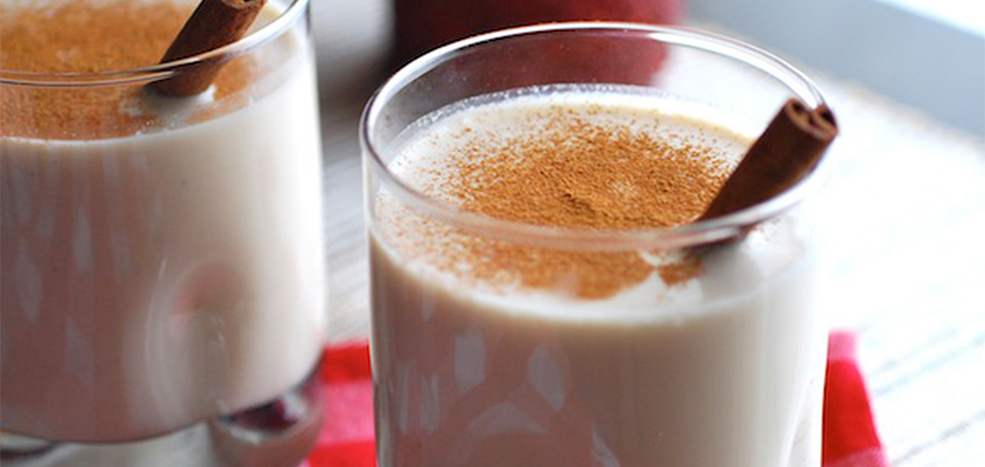
Coquito
Although coquito is certainly very rich, it's a little lighter than eggnog because it doesn't have eggs. The creamy component is a mixture of sweetened condensed milk, coconut cream, and coconut milk. For those who want it boozy, rum is the traditional option. A hefty dose of sweet wintery spices like cloves, nutmeg, and cinnamon make it taste like Christmas. If you're looking for something to serve at a holiday party this year, coquito is a real crowd-pleaser. You could even make little bottles of it to give to friends.
Pernil Asado
A traditional plate served around Christmas time, but can also be found in the mountainside of Cayey in the lechoneras of Guavate. This seasoned pork piece is slow-cooked and left in the oven for a few hours until the cuerito or rind is nice and crispy.
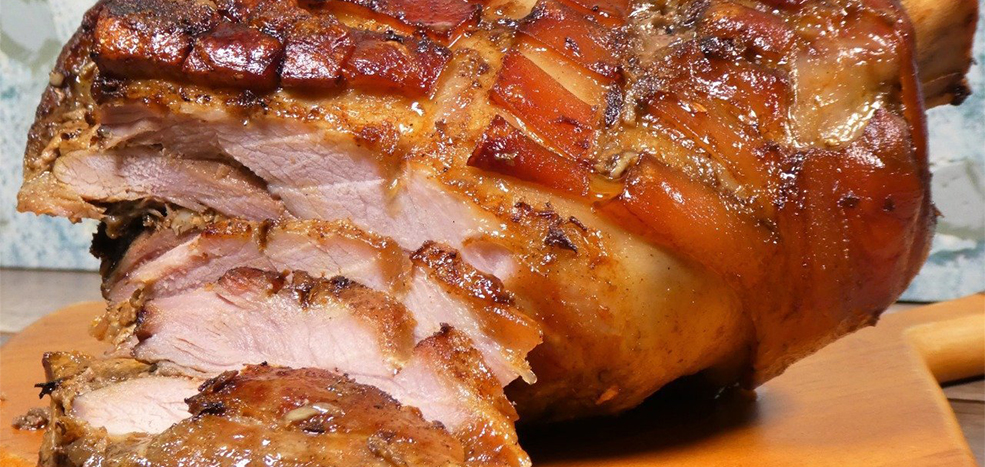
Pernil Asado
They douse the pig in salt, pepper, oregano, garlic, vinegar, water, and aji dulce (sweet cooking peppers) and cook it over a charcoal fire for hours until the meat is tender and the skin is crispy.
Pasteles
Pasteles are rectangular meat pies filled with a variety of ingredients, encased in masa dough that is then wrapped in a single banana leaf. The dough can be made with numerous ingredients such as cassava, taro, potatoes, or green bananas. The fillings are usually prepared with pork or chicken, with the addition of herbs and spices such as coriander and garlic, used to bring out the flavor of the meat.
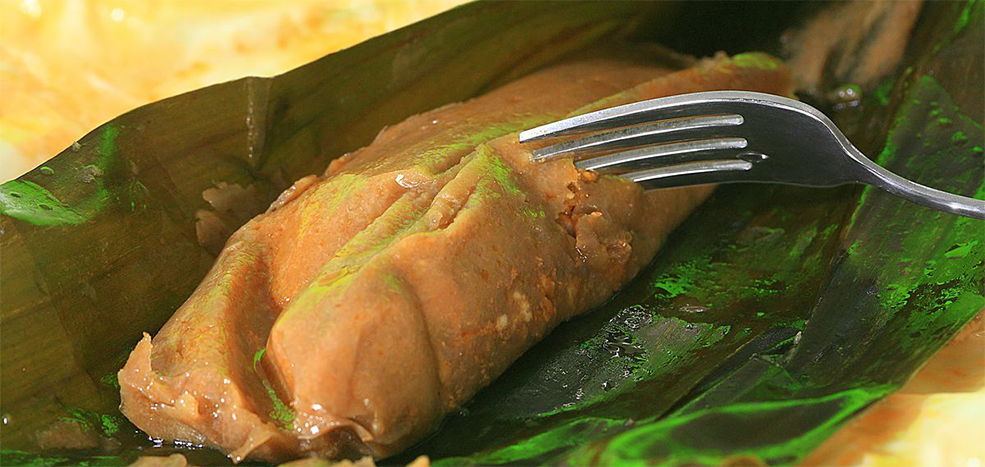
Pasteles
The typical condiments served with pasteles are ketchup, tabasco, or pique criollo, a hot sauce made from local hot chilis that have been pickled in vinegar. Pasteles can be accompanied by the arroz con gandules, see above, and pork.
Morcilla
In Puerto Rico, blood sausage is known as morcilla. Puerto Rican blood sausage is made with rice, culantro, cilantro, garlic, and Cubanelle pepper. Some contain paprika, annatto and some spices to give it a kick. Morcilla is especially popular during Christmas season.
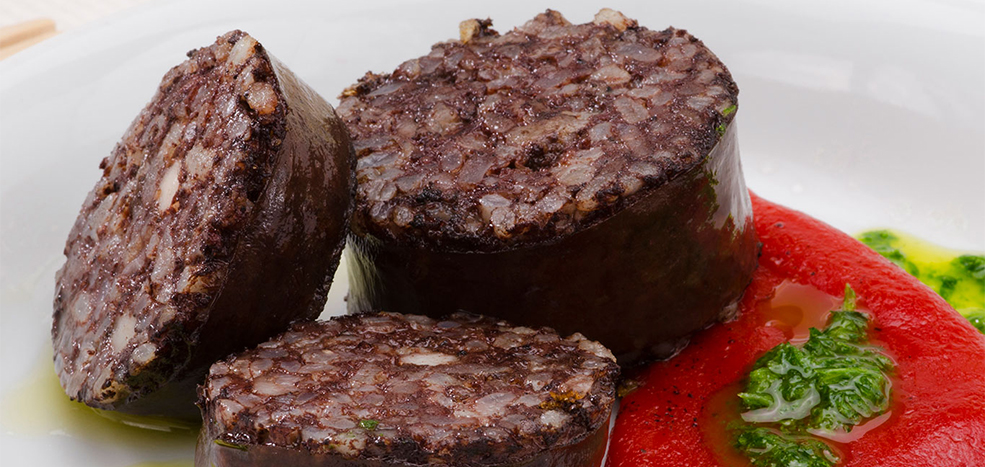
Morcilla
This Puerto Rican blood sausage is a Christmas tradition but is also served throughout the year in Guavate. It consists of a pork casing filled with pig’s blood, cooked rice, garlic, and other spices.
Typical Traditional Puerto Rican Food
Lechón Asado
When it comes to Puerto Rican dishes with pork, this one takes the cake! Puerto Ricans have perfected the preparation of lechon asado (roasted suckling pig), making it a culinary legacy on the island.
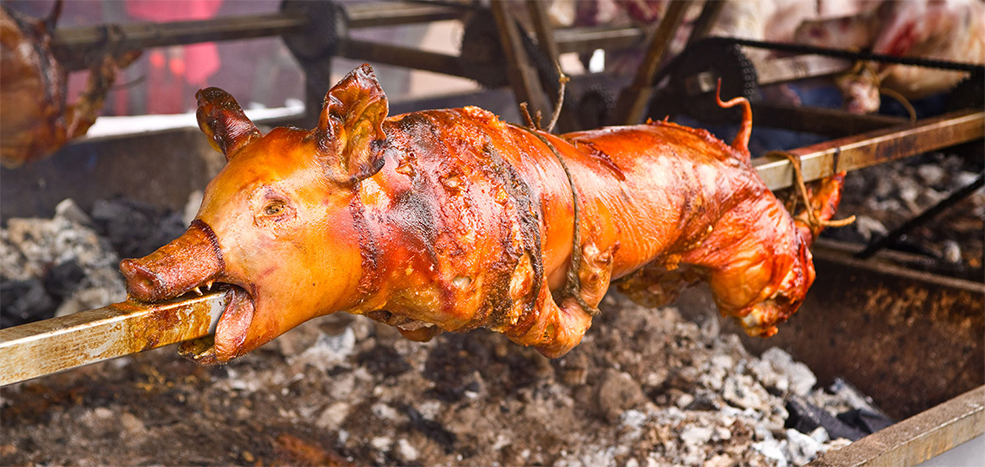
Lechón Asado
Lechon Asado is considered the most popular Puerto Rican holiday food! It essentially is a suckling pig roasted over charcoal. It is a traditional Puerto Rican dish that takes many hours to cook.
Bistec Encebollado
Bistec encebollado is a flavorful dish popular throughout Latin America, consisting of an adobo-spiced, marinated beefsteak combined with onion sauce and large onion rings on top.
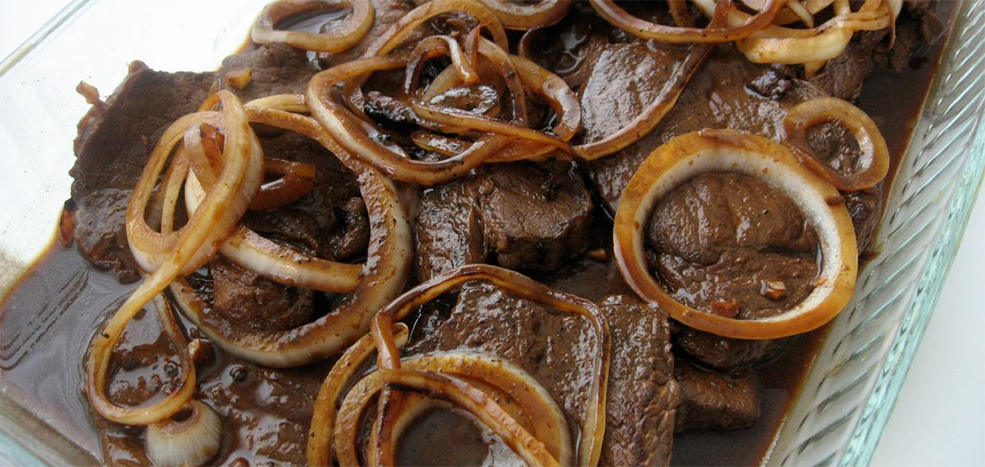
Bistec Encebollado
The wonderful flavors of bistec encebollado come from marinating the meat over a long period of time, usually anywhere from 10 to 12 hours. It is recommended to pair the dish with rice, pigeon peas, and fried plantains.
Guineítos en Escabeche
Guineos en escabeche is a marinaded green banana side dish that’s very popular in Puerto Rico. So popular in fact that the English name is simply Puerto Rican green bananas. Guienitos are often served for special occasions around the holidays but I find them tasty and refreshing as a summer side dish as well.
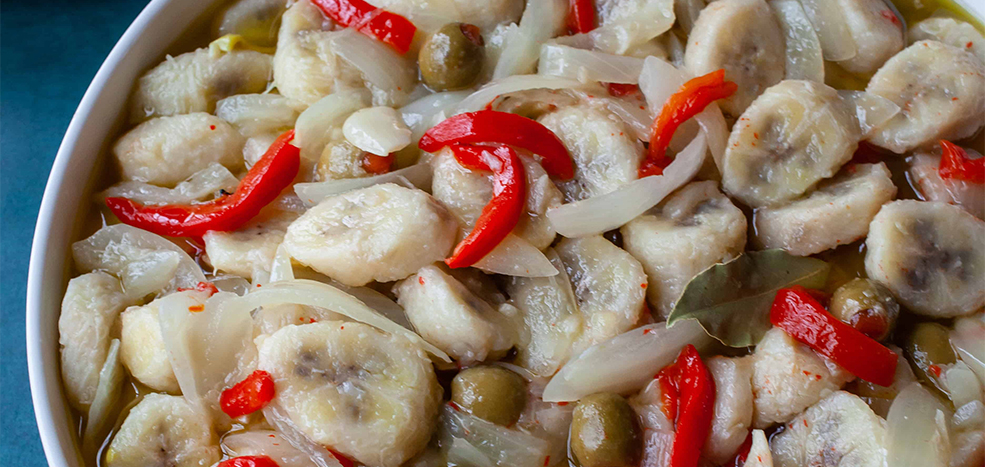
Guineítos en Escabeche
This is often a side to a rice dish, roasted pork, or any other meat. The guineítos consists of boiled green bananas that are marinated in a mixture of olive oil, vinegar, garlic, olives, and sauteed onions.
You May Also Like
-

06 Jul 2022
Puerto Rico Videos -

07 May 2022
Best Family Friendly Activities -

30 Apr 2022
Best Hiking Trails in Puerto Rico -

29 Apr 2022
Food Trails and Culinary Adventures -

29 Apr 2022
Puerto Rican Cocktails & Drinks -

28 Apr 2022
Landmarks and Iconic Places -

27 Apr 2022
Puerto Rican Traditional Dishes -

26 Apr 2022
Events and Festivals in Puerto Rico -

25 Apr 2022
The Musical Sounds of the Island -

25 Apr 2022
Art Museums in Puerto Rico -

24 Apr 2022
Puerto Rico Natural Wonders -

17 Apr 2022
Best Beaches in Puerto Rico -

17 Apr 2022
The Best Spots for Watersports -

10 Feb 2022
Puerto Rico – Island of Enchantment -

01 May 2018
Where to Surf in Puerto Rico

